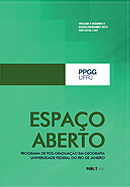Assessment of Transformations in Land Cover and Land Use in Angra dos Reis in 1985, 2001 e 2022
DOI:
https://doi.org/10.36403/espacoaberto.2024.63275Keywords:
Conservation Units, Slum, Indigenous Land, Remote SensingAbstract
The construction of BR-101, also known as the Rio-Santos highway, during the 1970s, and the inauguration of the Angra I and II nuclear power plants (in 1985 and 2001, respectively), were events that drove urban expansion in Angra dos Reis. Within this context, this article aims to study changes in land cover and land use, employing Landsat digital image processing from 1985, 2001, and 2022, in Angra dos Reis, including communities e favelas, and conservation units. The results obtained in the municipality reveal that, while the area of Tropical Rainforest increased by 1.49%, the urbanized area experienced a growth of 149.33% between 1985 and 2022. In favela areas, urbanization expanded by 273.49%, while the coverage of Tropical Rainforest decreased by 52.12%. In conservation units, the classes of urbanized area and Tropical Rainforest
increased, while the class of herbaceous rangeland decreased.
Downloads
Downloads
Published
How to Cite
Issue
Section
License
Copyright (c) 2024 Fábia Zaloti, Paulo Márcio Leal de Menezes

This work is licensed under a Creative Commons Attribution-NonCommercial-ShareAlike 4.0 International License.



